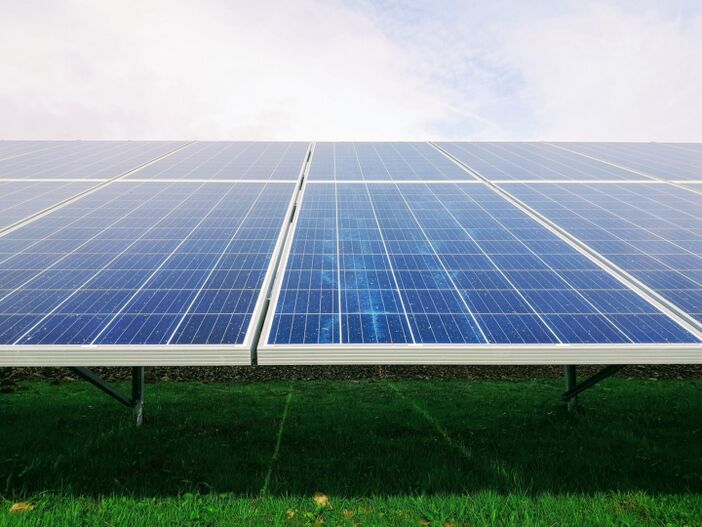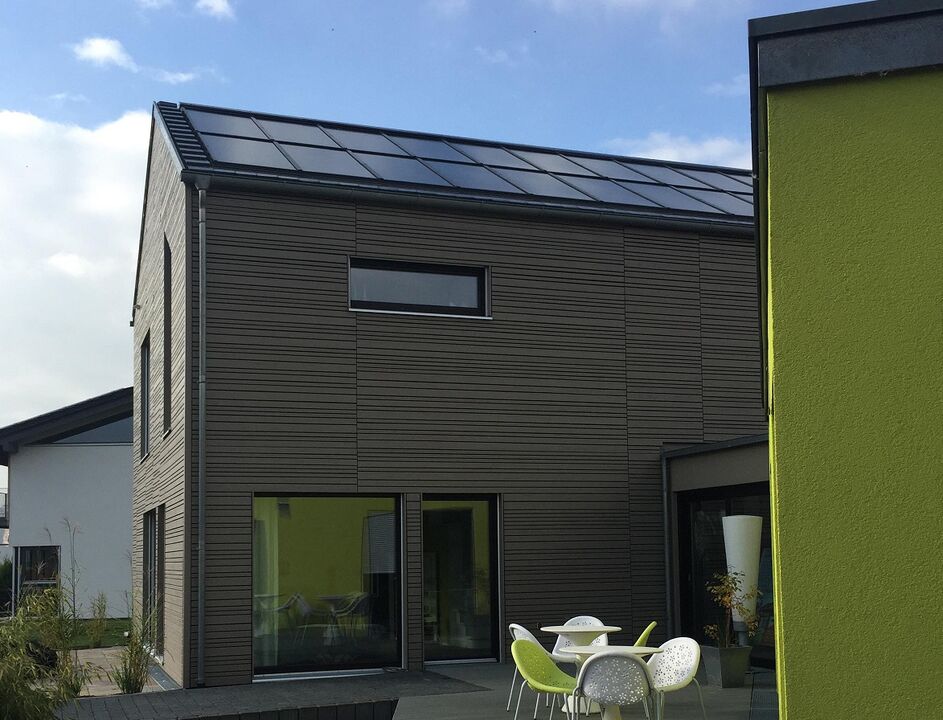
Unlike the powerful and expensive heating systems equipped in conventional houses, energy-efficient houses do not burn fuel or convert mains electricity into heat (except in cases of severe temperature drops). Such a house is able to persistently retain inside - thanks to thoughtful insulation, recovery ventilation and the optimal location of the building - the so-called passive heat. And anything can be used as a source of this passive energy:
- direct sunlight through the window;
- heat generated by household appliances and even people and pets;
- and of course, devices whose main function is to provide solar energy to the house - solar panels (batteries), will be discussed.
Solar panels fit harmoniously into a passive house, as they fully comply with the main principle of its construction - the use of renewable energy from the environment.

Principle of operation of solar panels and their interaction with other home systems
- The operation of solar panels is based on the conversion of thermal radiation acting on silicon panels into electricity;
- Solar panels allow you to use solar energy to operate household appliances, ventilation and heating systems (partly);
- If the capacity of solar panels is higher than household demand, the excess energy can be used in electricity storage and conversion systems.
- If the electricity demand exceeds the capacity of the panels, the missing part can be obtained from the network (optional in-network solar power station) or from a liquid fuel generator (autonomous solar power station).
Types of solar modules
The classification of photovoltaic systems is carried out according to the criteria of the materials and design used. Solar batteries are:
- In the form of silicon wafers (the most popular, highest performing and most expensive), efficiency - up to 22%; They are produced in three subtypes: monocrystalline (most reliable), polycrystalline, and amorphous; in the first two places, pure silicon is used, in the third - hydrogen silicon, which is applied to the substrate;
- Film - made of cadmium telluride, copper-indium selenide and polymers. They have a lower price, but also lower performance (5-14% efficiency), therefore, in order for the battery to suit the "taste" of the family, it is necessary to increase the radiation receiving area.
The consumer characteristics of solar panels are described by the following characteristics:
- Power.The larger the area of the solar panel, the greater its capacity; To generate 1 kWh/day of energy in summer, about 1. 5 m2 of solar panels will be needed. The most efficient energy is shown when the rays are perpendicular to the battery surface, this cannot be guaranteed continuously so changing the panel performance during the day is a natural process. To ensure the required amount of energy is obtained in spring and autumn, approximately 30% of this area must be replenished;
- Effective(efficiency) of modern solar panels - on average about 15-17%;
- Battery life and power loss over time. As a rule, manufacturers provide a guarantee for the operation of solar panels for 25 years, promising a decrease in electricity consumption during this period of no more than 20% compared to the original (for some manufacturers). production, service life varies between 10-25 years). with guaranteed capacity reduction of no more than 10%). Crystalline modules have the highest durability, their estimated lifespan is 30 years. The world's first solar battery has been operating for more than 60 years. The reduction in solar module output itself occurs mainly due to the gradual destruction of the sealing film and the scaling of the film between the glass and the solar cell - due to humidity, UV radiation and replacement. temperature change;
- Battery included, which ensures panel operation at night, is a good addition to the solar generator's capabilities. Batteries typically have a shorter lifespan than the solar module itself, on average 4-10 years;
- Availability of additional buttons– such as voltage stabilizers, battery charge controllers, inverters (DC to AC 220 V converters for household use) that make operating the device more convenient and integrating it into the system"Smart Homes";
- Battery costs– directly depends on its area: the more powerful the device, the more expensive it is. Furthermore, panels produced abroad are still cheaper than domestic panels because solar panels there are more popular than in our country. But when comparing the prices of our and imported equipment, first of all it is necessary to compare the performance of solar panels with each other - here domestic manufacturers achieve good performance indicators - upup to 20%.
Select and use photovoltaic batteries
When choosing solar panels for a private house, they must first of all be based on the load they will be subjected to. In addition, it is necessary to consider the shape of the house and the planning of preventive maintenance activities, which together require careful consideration of the following aspects:
- Daily energy consumption of devices expected to use solar energy (room lighting, household electricity consumers, security and automation equipment, etc. ). It should be borne in mind that charging and discharging the battery also consumes energy (about 20%), and additional devices will also suffer losses (for example, in an average inverter - 15-20%);
- The relationship between the required dimensions of the working panels and the corresponding roof area and its shape;
- The ability to clean the working surface of the battery from dirt, snow and other factors that affect the operation of the photo converter.
Important points in the operation of solar panels
- Avoid physical damage to the control panel (scratches and damage to the integrity of the protective film can lead to short-circuiting of contacts and/or corrosion);
- In harsh climatic conditions, solar power stations should be equipped with windproof structures;
- Regular inspection, cleaning and maintenance are required.
Cost and payback of solar panels
For the Central region of our country, each kilowatt of solar power generates the following amount of energy:
- in summer - 5 kWh/day (May-August);
- in spring and autumn - 3-4 kWh/day (March-April, September-October);
- in winter - 1 kWh/day.
When calculating the cost of an automated solar power station, in addition to the cost of one unit of electricity generated by the panels (about 60 rubles per 1 W), you need to take into account the cost of additional equipment. Additional: from fasteners and wiring to batteries, protection devices and inverters (at least 5% of the total cost, but prices can vary significantly, depending on the manufacturer and power source).
According to the recommendations of experts, the optimal cost of a year-round solar energy system is obtained by using the "summer option plus backup generator" option. That's right, the generator will have to be turned on in the spring and fall, not to mention in the winter (solar batteries were never designed to be fully charged in winter).
When calculating the payback period of a solar installation, its output is compared with the parameter taken as a basis. In a grid solar station, this is the price of electricity; In the case of an autonomous solar system, this is the cost of the energy produced by the liquid fuel generator. The estimated payback is based on the fact that a 1 kW solar panel will produce approximately 1000 kWh of energy per year.
If we take the average price of 1 kWh of electricity as 5 rubles, then the payback period of a solar power station in the network will be: 80, 000 rubles / 5 rubles * 1000 kWh = 16 years.
With a 30-year guarantee for the installation of the solar network, the payback (at a price of 5 rubles/kWh) will take place within 16 years, and for the next 14 years, electricity will be provided for free.
For an autonomous solar system, strictly speaking, the amount of energy it produces each year will be less than the specified 1000 kWh it shares with the generator. But for preliminary calculations, this figure does not need to be reduced - to take into account the increase in specific fuel consumption that occurs when the generator is partially loaded (that is, periodically, intermittently). ). Then the payback period of the autonomous system (based on the cost of energy generated by the liquid fuel generator - 25 rubles per 1 kWh) looks like this: 150, 000 rubles / 25 rubles * 1000 kWh= 6 years.
In addition to technical indicators, the performance of solar panels of an autonomous solar power plant is also confirmed by a payback period of 6 years.
Tariffs are not reduced
However, the examples of solar installations given show that tariffs can now be individually "frozen" and you can start saving by taking advantage of the possibilities of photovoltaic panelselectricity. You just need to buy them from branded manufacturers, tested on the market to be able to predict their parameters in both design and operation.
And it is best to address issues such as: even at the stage of designing an energy efficient house:
- Make sure the south-facing facade is not shaded by the sun;
- selection of the angle of inclination of the roof and the working surface of the panels;
- correct orientation of the house to key points;
- Prevents shading the working area of solar panels, clogging them with leaves, etc. v.

In this case, all parameters will be optimally linked to each other and the most efficient operation of solar panels for a particular structure will be guaranteed.
























